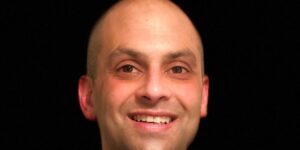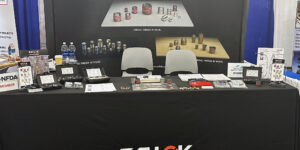PUSHING THE ENVELOPE
Leading Edge: Check out how this manufacturer develops new ways to solve fabricating challenges with multi-axis laser machining systems.
Posted: November 17, 2008
Multi-axis laser technology has a reputation for pushing the envelope, often driven by a champion of the technology who embraces it with creativity and zeal and takes it to new levels. LAI International, Inc. (Scottsdale, AZ), a strategic supplier of precision components and sub-assemblies for original equipment manufacturers, champions advanced laser machining in its multiple facilities nationwide.
Rich Technology International (Scarborough, ME) is a diversified contract manufacturer and one of the five LAI manufacturing facilities dedicated to supplying precision engineered components and assemblies to the aircraft, power generation and defense industries. With its laser systems, Rich Technology does high-volume work and specializes in processing difficult materials such as Inconel, stainless steel, super-cobalt alloy, hybrid nickel, chrome steel and Hastelloy X.
For more than three decades, Eric Nelson, the vice president and chief technology officer of LAI, has remained committed to one brand of laser system, Laserdyne from Prima North America, Inc., to apply, challenge and help improve multi-axis laser technology for the most difficult aerospace and power generation applications. Along the way, he has literally done it all – from pioneering the use of factory-rebuilt systems, to beta testing and offering suggestions for developing hardware and software features which have become standard offerings, to routinely increasing productivity and quality with the laser systems he utilizes.
"We operate seven multi-axis laser systems here at our Scarborough facility," reports Nelson, "including five 780 BeamDirectors® and two 890 BeamDirectors®. All are refurbished systems which we regularly upgrade with new software and hardware from the OEM so that they have the functional capabilities of new machines. By keeping up on everything new and implementing those things that can immediately help us, we provide customers like General Electric and Pratt & Whitney with the most productive and highest quality processes. We produce those really difficult parts efficiently for them."
Half of the Scarborough laser jobs are for the aerospace industry and the other half is devoted to land-based turbines. Some of this work cannot be done efficiently using other processes, such as EDM or waterjet machining. The laser work can call for drilling thousands of holes in a single part, everything from 0.003 in diameter rounds, to percussion drilling and trepanning special shapes. Drilling angles range from 90 deg to as low as 10 deg to the surface.
Laser processed parts range from 10 in long Inconel aerospace vanes to 110 in diameter chromium alloy land-based turbine spacer bands. A typical job, such as the spacer bands, requires laser cutting a series of accurately spaced complex profiles along the part contour. Part runs for this job average 40 to 50 sets a week using one of the refurbished 890 BeamDirector systems equipped with a 3000 W CO2 laser. The material is 440 stainless steel with a chrome additive, a very hard material, but this is processed efficiently on the system with consistently smooth, burr-free edges. Accuracies are a tight 0.004 in true position total tolerance for the special airfoil shape and the speeds are relatively fast considering the geometry of the part features, according to Nelson.
"Achieving this level of productivity and accuracies from one job to another is possible because of how the laser design integrates its system features," reports Nelson. "Everything works perfectly together – the controller, software, motors, laser – because everything is OEM design and manufacture."
A perfect example is the Automatic Focus Control (AFC?), a system feature Nelson swears by and one with which he provided feedback to his supplier and saw the control refined through the years. AFC guides the motion system, maintaining critical focus position and following the contour of the part regardless of slight surface irregularities. With AFC, all machine axes react to sensing of the part surface, creating unlimited R-axis correction with high speed and unmatched sensitivity. AFC allows top machine speeds so productivity is maximized without downtime or scrapped parts.
LAI uses trepanning, percussion drilling, and drill-on-the-fly laser processing techniques in which the AFC feature is extremely important in the laser drilling processes. Trepanning is a process for creating holes where the part is held stationary and the laser beam is moved with simultaneous multiple action motion to create a round hole or any feature by cutting the periphery of the shape. The extremely accurate and repeatable laser postioning systems allow for very unique and tight tolerance trepanned features.
In contrast, percussion drilling delivers one or more pulses from the laser to a part while the laser beam and part are stationary. More than one pulse may be required depending on the material type and thickness. A variation of percussion drilling is drill-on-the fly, where pulses are delivered to the part by the stationary laser while the part is rotated. The hole placement is a function of rotational speed and laser pulse frequency. If multiple pulses are required, drill-on-the-fly software developed by Laserdyne engineers is utilized to synchronize the movement of the part to the laser pulses and ensure that multiple pulses are delivered to the exact location required.
By changing the laser pulse energy, pulse count or lens focal length, the characteristics of the drilled hole size and taper can be controlled to meet the requirements of the part. Drill-on-the-fly software also allows changes of the pulse shape during the process to improve hole geometry. "System repeatability to ±0.0001 in of the machine really comes into play on our jobs," adds Nelson. Our 890 and 780 BeamDirectors with Automatic Focus Control features are designed to maintain extremely good accuracy, with consistency through the entire work envelope."
Nelson explains why he chose this particular multi-axis laser technology early on and stayed with it for decades: "Like any customer when multi-axis laser revolution began in the 1980s, I wanted to go with the best. After exploring different models and makes, only one manufacturer offered systems with fully integrated software and hardware components of their own exclusive design and manufacture. Our supplier is the only manufacturer who continues to manufacture their own controllers, workstations and lasers. This was true then and it is still true now. All of the modules work together the way they should. If a problem occurs or there is an opportunity to improve the process, there is one point of responsibility to get it right and that's always been our supplier. This is the key to doing the best work and it is the real reason we are able to push the technology edge and do multi-axis laser work where alternative processes and systems either have limitations or just won't do the job."
Peter Thompson, the technical director of Laserdyne, explains his company's approach to integrating all system components: "We learned in the early days of operation that the key to getting the most from multi-axis laser processing required integrating the laser, motion system and control, user interface, and process sensors. The only way to do that was to design, manufacture, and integrate all of these components ourselves in the system. Our goal has always been to provide systems that were capable of the finest precision laser processing. Designing and manufacturing all of the major components of the system also allows us to introduce technology as it becomes available and to more tightly integrate the various components. The end result is superior process capability and control."
"Drilling with today's systems integrates the optics of the laser with sensors in the machine tool structure and with the motion system," remarks Thompson. "All are optimized for the unique work required of multi-axis laser processing. Remember, there are no significant tool forces with multi-axis laser processing and especially laser drilling. Without precise control over key components, it would be difficult for end users to achieve the performance levels, the speeds and quality our laser systems deliver. The performance LAI is achieving is just too difficult to accomplish by ?bolting together' a collection of commercially off-the-shelf components. For this reason, we refer to our products as systems and not just lasers or machine tools."
Smaller aircraft engine components can be laser processed, in volume, with repeatable profile accuracy and true position of less than 0.004 in. With equipment options that include waterjet and EDM, Nelson's equipment preference for laser drilling aircraft vane sector components is a multi-axis laser system with a BeamDirector, because it provides higher feed rates and is more accurate. The Inconel part sets up quickly with minimal clamping pressure. Multi-axis laser machining is essentially a non-contact process, so highly rigid part clamping is not required. Using an updated 780 BeamDirector equipped with a 1500 W CO2 laser, 1500 to 2000 of these parts are laser processed at LAI, week after week, with only minimal operator adjustments.
Repeatability like this, with positioning accuracy, is a cumulative result of many factors working together that affect the overall laser system's accuracy and the quality of the parts produced. Even system frames have an important influence on the successful integration of system components. The bases of the 780 and 890 BeamDirector systems are carefully-engineered foundations on which integrated accuracy features have been built. Most laser machining systems are not rigid enough to isolate and eliminate the vibrations induced by continuous back and forth movement of a few thousandths of an inch necessary in many of our projects, states Nelson.
"The multi-axis laser stands out as a very unique manufacturing system in today's broad array of fabricating systems," says Nelson. "Getting the most out of a machine is one thing. Getting the most out of an entire manufacturing technology is something else. It is much more challenging today because part features, hole configuration and size, material difficulty, speed and the quality required have exceeded anything thought possible even just a few years ago, let alone when this all began twenty years ago. We're meeting those challenges and more."
The company also operates three additional 94 W laser systems with process controls at its facility in Tucson, AZ. These workstations can handle rotary parts up to 48 in diameter, pre-formed parts up to 24 in high, and materials thicknesses from the thinnest gauges to 1 in. "We employ percussion, trepanning and drill-on-the-fly laser drilling techniques for effusion cooling holes as well as full five-axis laser cutting on the pre-formed parts our customers supply," says Mike Grantham, the technical director of LAI Southwestern Laser, a division of the parent company. "This facility can drill holes as small as 0.005 in diameter at angles from 20 deg to 90 deg to the surface."
– – – – – – – – – – – – – – – – – – – – – – – – – – – – – – – – – – – – – – – – –
Laserdyne Systems, Prima North America, Inc., 8600 109th Avenue North, #400, Champlin, MN 55316, 763-433-3700, Fax: 763-433-3701, www.prima-na.com.
LAI International, Inc., 8147 E. Evans Road, Suite 9, Scottsdale, AZ 85260, 480-348-5942, Fax: 480-368-2830, www.laico.com.









